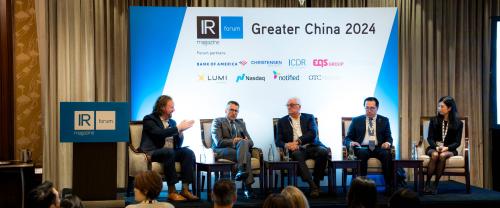The first round of Mifid regulation was introduced by the European Union in 2007 to harmonize regulations for investment services throughout its member states. But most US-based IR professionals did not take much notice until Mifid II was enacted in January 2018.
Mifid II’s primary thrust is aimed at unbundling broker commissions and forcing research to become a ‘priced’ service, rather than the loss-leader it had become, to drive trading flow and investment banking advisory work at the largest brokers. Much focus has been on how these regulations will affect the relationship between the buy side and the sell side, but less focus has been directed at the third stakeholder in the capital markets: the corporate.
Here are the five ways we expect Mifid II to affect corporates, specifically IROs, in the coming years.
1. Investor access will be procured by the buy side, rather than the sell side
Capital markets have operated in a consistent way over the last century, with brokers acting as the intermediary and matching investors with the right corporate stock. Brokers bring subject matter expertise, liquidity and access based on their deep relationships with investors and corporates alike, which serve as an efficient conduit for the investor. These attributes enable brokers in most instances to be the primary influencer in making investor/corporate matches.
Objectively, this appears to be a fairly efficient system: around $6 bn globally and more than $2 bn in the US is spent by investors to gain corporate access through brokers via conferences and non-deal roadshows, for example. But institutional investors have a fiduciary duty to invest their investors’ resources prudently; setting up a meeting for $2,000 seems rich and difficult to justify.
As a result, several of the largest buy-side shops are opening their own corporate access departments. Taking a deeper look at this solution, IROs can now expect more frequent inquiries from investors, rather than through organized broker-sponsored events. The good news is that this ‘buyer’ is interested and coming directly to the IRO, but the bad news is that the organization of these inbound requests is shifting more of the logistical planning and organization from the broker to the IRO.
2. IROs need to invest more in targeting capabilities
For IROs, this model carries another concern bigger than the logistical nightmare coming their way. Brokers used to do a lot of work profiling investors based on their relationship knowledge, which enabled them to place the marginal, undecided investor in front of management to hear the story and potentially become a shareholder. If the industry relies less on the broker to find these potential new buyers, IROs will need to pick up this work on their own.
This creates the need for IROs to invest in data and technology solutions that enable them to better understand not only which investors are potential buyers of their stock, but also when and why certain investors are most likely to buy a specific stock.
An example of rudimentary targeting used by many IROs today would be: you are a small-cap tech company and your executives will be in Boston next month, so you meet with investors that have invested in you, your peers and small-cap tech. In the world of big data, more intelligent targeting (who, what, when, where, why and how) is becoming possible for the IRO:
- Who are the investors looking to invest in a company with attributes matching mine?
- What market conditions influence an investor to be more likely to pay attention to my stock?
- When are these investors likely to buy or sell my stock?
- Where do these investors gain exposure to my investment story (stocks, options, exchange-traded funds, and so on)?
- Why do these investors care about my stock now? What specific attributes most influence them?
- How much could this investor buy?
3. Investors will have reduced access to decision-support materials on less-known stocks
Think about investors that no longer have the broker facilitating the meeting. They might have an internal quantitative model that screened your name as an attractive opportunity, or they could have read a piece of research or a blog that caught their attention. Still, preparation and subject matter sophistication likely will suffer as more meeting procurement is facilitated directly by the buy side, rather than through a broker.
In many cases, investors potentially interested in meeting with your executives will not have reviewed a working pro forma model in advance of the meeting, previewed your latest slide deck, or looked over the key questions that were most important to the Street on your last earnings call.
Brokers are less likely to be involved, incentivized and in most cases even aware of these buy-side procured meetings. As such, IROs are certain to be tasked with investing more time supporting the marginal investor in becoming educated and comfortable with the investment risks and highlights ahead of executive access.
4. Independent research will flourish – over time
One of the more controversial topics is how research will change post-Mifid II. Three things are certain:
- Research will become a priced commodity
- Research will no longer be supported as a loss-leader being subsidized through attachment to a trading desk/investment bank, lowering the barriers of entry
- Quality research will be able to fetch prices that are higher than any other form of content creation because of the potential value generation.
In the near term, the research market will take a hit as too many low-quality providers are offering and monetizing redundant products and services. Over time, however, the independent research industry can be expected to flourish. Therefore, IROs must understand that the influencers of their stock are much broader than covering sell-side analysts.
Best-in-class IROs must remain educated about the flow from these independent sources and keep lines of communication open so that accurate information is shared through these channels. Moreover, as active investment becomes increasingly data-centric, or ‘quantimental’, the influence that comes from the blogosphere on investor and consumer sentiment is increasingly more important than the opinions of a few Street experts.
5. In maintaining impeccable investor access, data will become a critical driver of stock value
As with any business that faces significant disruption from regulation or other external influence, IROs should maintain well-organized and extensive data on process and outcome so that behavior can be appropriately monitored, modified and optimized. Many systems are emerging to help IROs better address their relationships with investors and to understand how to run IR like a business, focusing on ROI and other metrics that matter most to each specific company over time.
Conclusion: Mifid II will result in IROs taking on more responsibilities in areas traditionally supported by brokers
Mifid II is arguably the most significant regulatory change to affect the three stakeholders in the capital markets (investors, brokers and corporates) since Regulation FD nearly two decades ago. Regulation FD compromised the position of the broker, as sell-side research was no longer the conduit through which corporates shared information with investors. Mifid II takes it a step further, making it difficult for brokers to get paid for arranging meetings to monetize their corporate relationships.
Over the next decade it should be expected that corporate IR will take on more of the responsibilities traditionally sponsored by brokers: targeting, meeting procurement and meeting preparation. Investor access will become an even more resource-intensive requirement for corporate IR.
Peter Wright is co-founder of Intro-act










